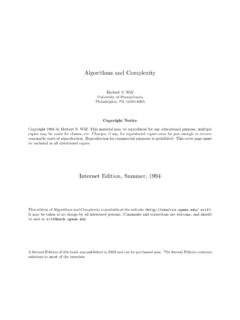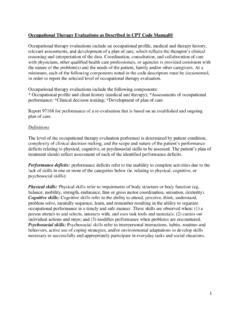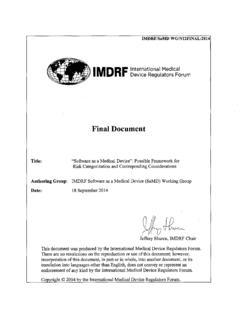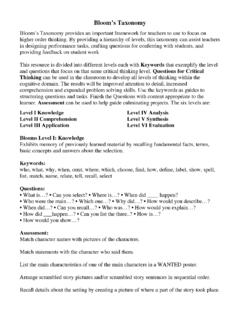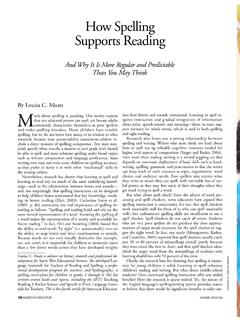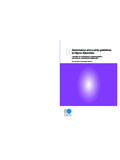Transcription of Complex Adaptive Systems and Complexity Theory: Inter ...
1 Complex Adaptive Systems andComplexity Theory: Inter -relatedKnowledge Domains byRebecca Dodder and Robert : Research Seminar in Engineering SystemsMassachusetts Institute of TechnologyOctober 31, 2000 IntroductionThis paper provides a description of two highly interrelated knowledge domains: Complex Adaptive Systems (CAS) and Complexity Theory. The initial sections providean overview, descriptive characteristics, background and social/institutional outlines forthe Complex Adaptive Systems knowledge domain. The next four sections providedescriptive material on applications of CAS thinking in the disciplines of physics,biology, economics and political science. While CAS has implications for many otherdisciplines, these sections illustrate how CAS thinking has found its way into ongoingtheory development in a representative set of fields. The next sections of this paperdescribe the highly related knowledge domain of Complexity Theory, providing materialon identifying and measuring Complexity , and the relationship of Complexity toengineering Systems .
2 The last section provides some closing thoughts on the outlook forthese two closely related knowledge of Approach to Complex Adaptive SystemsThe rise of Complex Adaptive Systems (CAS) as a school of thought took hold in themid-1980 s with the formation of the Santa Fe Institute, a New Mexico think tank formedin part by former members of the nearby Los Alamos National Laboratory. Participantsat the Institute have come from such diverse disciplines as economics, physics, biology,ecology and archaeology. The Institute formed to draw from and further developthinking over the previous twenty years in a variety of disparate fields on the issue ofcomplexity. More information about the formation of the Santa Fe Institute is included inthe background section important emphasis with CAS is on crossing of traditional disciplinary provides an alternative to the linear, reductionist thinking that has ruled scientificthought since the time of Newton.
3 The new discipline has been distinguished byextensive use of computer simulation as a research his book, Complexity : the Emerging Science at the Edge of Order and Chaos ,author M. Mitchell Waldrop describes the objectives associated with the developmentand use of CAS concepts. Santa Fe members sought to pursue a common theoreticalframework for Complexity and a means of understanding the spontaneous, self-organizingdynamics of the of CAS are widespread in both the natural and human world. In the naturalworld, brains, immune Systems , ecologies, cells, developing embryos, and ant colonies allfall under the category of CAS. In the human world, political parties, scientificcommunities and the economy are have several common characteristics that recur in a number of natural and humancontexts. The most commonly repeated characteristics noted in the literature are asfollows: CAS are balanced between order and anarchy, at the edge of chaos.
4 As Waldrop(1992) describes, ..frozen Systems can always do better by loosening up a bit, andturbulent Systems can always do better by getting themselves a little more if a system isn t on the edge of chaos already, you d expect learning and evolutionto push it in that make the edge of chaos stable, the natural place forcomplex, Adaptive Systems to be. CAS are composed of a network of many agents gathering information, learning andacting in parallel in an environment produced by the interactions of these agents. The system co-evolves with its environment. Order is emergent, instead of pre-determined, always unfolding and always intransition (perpetual novelty). CAS tend to exist in many levels of organization in the sense that agents at one levelare the building blocks for agents at the next level. An example is cells, which makeup organisms, which in turn make up an ecosystem. Finally, CAS, by their nature, have a future that is hard to characteristics are illustrated in the examples of CAS application to differentdisciplines included of CAST hinking about CAS has its roots in many different disciplines.
5 Waldrop (1992)indicates that efforts at the Santa Fe Institute to conceptualize a common theoreticalframework for Complexity were built upon past work in the fields of neural networks,ecology, economics, artificial intelligence, chaos theory and before the Santa Fe Institute got underway, Belgian Nobel laureate Ilya Prigoginewas exploring questions about the sources of order and structure in the world. Waldrop(1992) indicates that Prigogine had been studying self-organizing structures in naturesince the 1960 s. He observed that atoms and molecules are exposed to energy andmaterial flowing in from the outside, partially reversing the decay required by the secondlaw of thermodynamics. As a result, Systems are able to spontaneously organizethemselves into a series of Complex structures. This work resonated with many of theSanta Fe founders and represented some of the early thinking on self-organization of the key figures in CAS have a strong affiliation with the Santa Fe include institute founder and first president, George Cowan who had previouslyworked on the Manhattan project and headed research at Los Alamos.
6 Cowan wasdescribed by Waldrop (1992) as ..a fervent and determined Cowan, the SantaFe Institute was a chance for science as a whole to achieve a kind ofredemption and rebirth. Murray Gell-Mann, winner of the Nobel Prize in physics for his work on sub-atomicparticles, was a fervent supporter of the formation of the institute, and has retained astrong affiliation over the years. Stuart Kauffman was a leading figure in biology, whowrote about the relevance of adaptation in addition to Darwinian selection in theevolution of species. Major works written about Complexity theory by Gell-Mann ( TheQuark and the Jaguar ) and Kauffman ( At Home in the Universe ) are described Holland s involvement at Santa Fe stems back to early workshops at the institutewhere he shared his thinking on key ideas on adaptation that he had been pursuing inrelative obscurity for a quarter of a century. Holland s book entitled Hidden Order isanother major work in the Arrow, a Nobel laureate in economics, was another key participant in the earlydays of the after the Santa Fe Institute was established in 1984, the members held a series ofworkshops, which brought together Inter -disciplinary figures at the leading edge of theirrespective fields.
7 This activity jump-started many interdisciplinary connections that arestill developing today. Since its formation, the Institute has taken the form of a smallpermanent staff and a large number of visiting CAS concepts have not yet achieved mainstream acceptance in the scientificcommunity, the Santa Fe Institute remains a powerful force in developing and promotingthis body of and Institutional OutlinesCAS is a multi-disciplinary field with participants from physics, biology, economics,archaeology, computer science and many other fields. No one field seems to dominatethe addition to the Santa Fe Institute, which is described above, the New EnglandComplex Systems Institute (NECSI) is another organization with a strong intellectualcommitment to the study of Complexity and CAS. According to its website, NECSI is an independent educational and research institution dedicated to advancing the study ofcomplex Systems . NECSI joins faculty of New England academic institutions in aneffort to collaborate outside of institutional and departmental boundaries.
8 Sponsors ofNECSI include the National Science Foundation, Boeing, Microsoft Research, LeBaronFoundation, Group Health Cooperative, Pan Agora Asset Management, and the universities have programs or workshops associated with CAS. Chalmer sUniversity of Technology in Sweden offers a masters degree in Complex AdaptiveSystems. Iowa State University has sponsored a CAS workshop. The University ofFlorida, Arizona State University, and other schools have content on their websites thatdirectly relates to CAS are four primary journals in the field. Complexity is a multi-disciplinary journalpublished by John Wiley and Sons. Journal of Complexity has a strong mathematicsorientation and is put out by Academic Press. Interjournal is a web-based publicationsponsored by NECSI. Complexity International is put out by Charles Sturt sites for these journals are listed in the references in PhysicsOne of the most famous writers on CAS is physicist Murray Gell-Mann, whose bookentitled The Quark and the Jaguar explores the relationship between the simple and thecomplex.
9 The simple refers to underlying physical laws of matter and the universe. Gell-Mann asserts that the fundamental laws are quantum-mechanical. Therefore, sincequantum mechanics supplies only probabilities for alternative coarse-grained histories ,chance must play a role in the unfolding of the universe. Gell-Mann s work onsubatomic particles won him the Nobel Prize in Complex includes the rich fabric of the world that we perceive directly and of whichwe are a part. He sites a range of Earthly Complex Systems from the prebiotic chemicalreactions that first produced living things, through biological evolution and the culturalevolution of humanity, all the way to computers equipped with appropriate hardware orsoftware and to possible future developments treated in science fiction, such as compositehuman beings formed by wiring people s brains together. Gell-Mann describes the role of chance as having a fundamental role in the description ofnature.
10 In his view, each alternative history of the universe depends on the results of aninconceivably large number of accidents. Self-organization occurs through acombination of such frozen accidents and the fundamental describes the behavior of CAS, saying that they take in coarse grained information about the universe, find perceived regularities and ignore the remaininginformation as being random. The regularities lead to formation of schema, whichprovide a description of the world and allow the CAS to prescribe behavior forthemselves. This sequence leads to the emergent behavior observed from complexadaptive in BiologyStuart Kauffman, another influential thinker associated with the Santa Fe Institute, wrotea book entitled At Home in the Universe to explain his perspectives on Complexity inthe field of biology. Kauffman finds that a combination of natural selection and self-organization leads to matter organizing itself into Complex structures in spite of the forcesof entropy.











